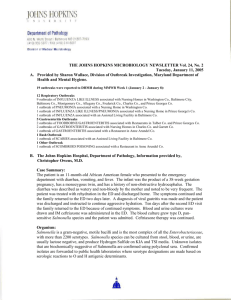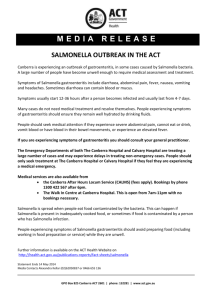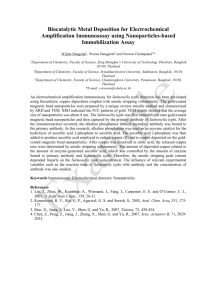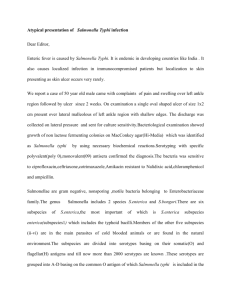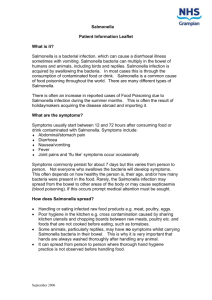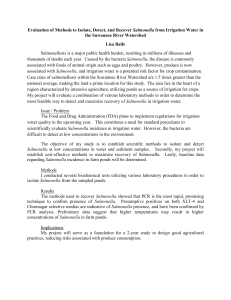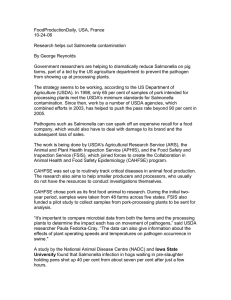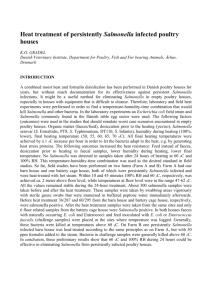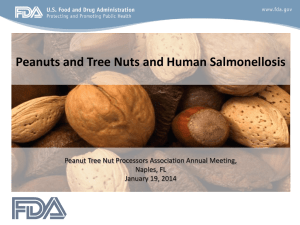Salmonella
advertisement
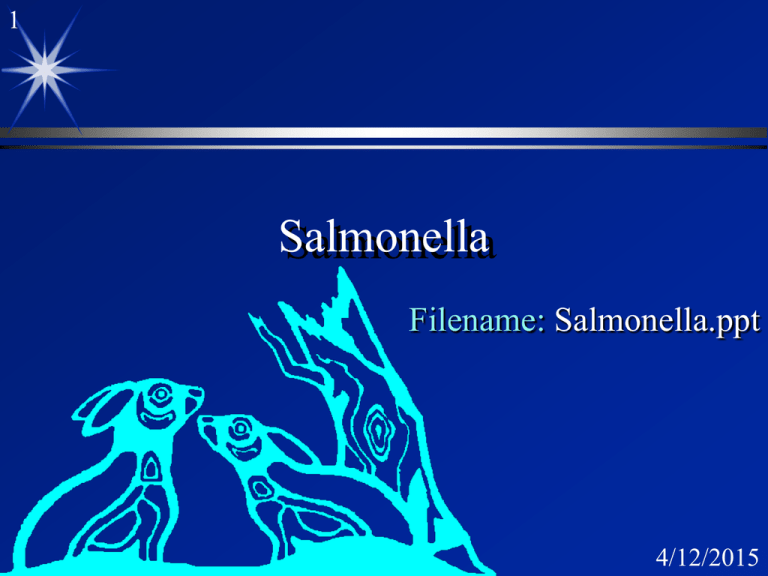
1 Salmonella Filename: Salmonella.ppt 4/12/2015 2 Salmonella Nomenclature Incidence Clinical syndromes gastroenteritis typhoid fever 4/12/2015 3 Salmonella 2,000 serotypes Subgroup 1 S. cholerae-suis S. typhi S. enteritidis Human Pathogens Salmonella typhi Salmonella paratyphi subgroups 2-5 cold-blooded animals environment 4/12/2015 4 S. cholerae-suis: Transmission Humans to animals Animals to humans Humans and animals to animal feeds Large Inoculum: 106 4/12/2015 5 Incidence in Ontario 1994 typhoid paratyphoid salmonellosis 1003 1992 6 85 639 1991 6 152 581 4/12/2015 6 Salmonella: Clinical Syndromes Gastroenteritis Bacteremia: followed by gastroenteritis Enteric fever Asymptomatic colonization 4/12/2015 7 Salmonella: Gastroenteritis incubation 6-48 hrs. nausea, vomiting, diarrhea, fever, abdominal cramps, myalgia, headache 2 days - 1 week: usually spontaneous resolution 4/12/2015 8 Mechanism of Pathogenicity Gastroenteritis ingestion absorbed to brush border of epithelial cells of small intestine and colon migrate to lamina propria, ileocaecal multiply in lymphoid follicles reticulendothelial hyperplasia and hypertrophy 4/12/2015 9 Hyperplasia vs Hypertrophy Hyperplasia : abnormal increases in the number of normal cells (organ swells) Hypertrophy : increase in size of an organ 4/12/2015 10 Salmonella:Bacteremia Usually caused by S. cholerae-suis S. typhi S.paratyphi S. dublin Complications osteomyelitis (10%) arthritis endocarditis Gram negative bacteremia is non-suppurative 4/12/2015 11 Enteric Fever: S. typhi ileocaecal penetration intraluminal multiplication mononuclear response (macrophages) Salmonella remains alive 2nd week - lymphoid hyperplasia (mesenteric lymph nodes) back to bowel 4/12/2015 12 S. typhi found in stool - enteric media and selenite enrichment high antibodies 4/12/2015 13 Mechanism of Fluid Secretion Stimulation Arachidonic acid with the enzyme cyclooxygenase stimulates the production of prostaglandin which then causes an increase in cAMP (cyclic adenosine monophosphate) and stimulates fluid secretion. 4/12/2015 14 Reduction of Fluid Secretion Anti-inflammatory drugs aspirin - non-steroidal, anti-inflammatory inhibits cyclo-oxygenase which is necessary to produce prostaglandins 4/12/2015 15 The End 4/12/2015

